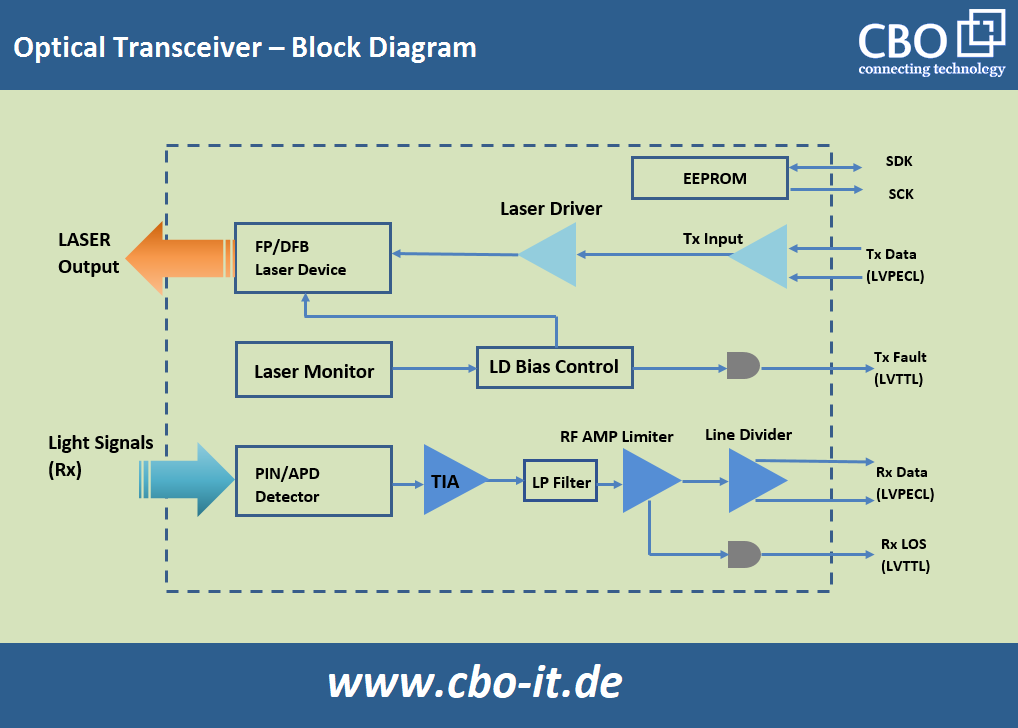Optical transceivers are devices that transmit and receive optical signals over optical fibers. They are crucial in optical communication networks, connecting various network components such as switches, routers, and optical amplifiers. The use of optical transceivers has been growing in recent years due to the increasing demand for high-speed data transfer in telecommunications and data centers.
Working Principle of Optical Transceivers
Optical transceivers contain a transmitter and a receiver in a single compact package. They convert electrical signals into optical signals for transmission over optical fiber and vice versa. The transmitter part of the transceiver is responsible for converting electrical signals into optical signals. In contrast, the receiver part is responsible for converting the optical signals back into electrical signals.

Classification of Optical Transceivers
Optical transceivers can be classified into different types based on the wavelength of their optical signals. The most commonly used wavelength is 850 nm for short-distance communication and 1310 nm for long-distance communication. Different transceiver types also have different data transfer rates, with some capable of transmitting data at speeds of up to 800 Gbps.
Why Fiber is better than Copper?
In optical communication networks, optical transceivers transmit data over long distances, providing faster data transfer rates than traditional copper wire networks. They also offer several advantages over copper wire networks, including increased security, lower power consumption, and lower interference. Additionally, optical fibers can be bent and shaped to fit into tight spaces, making them ideal for use in data centers and other confined areas.
Optical transceivers also play an essential role in reducing the cost and complexity of optical networks. By using a single compact device to transmit and receive optical signals, the need for separate transmitter and receiver devices is eliminated, reducing the network's cost and complexity.
Optical Vs. Copper Transceivers
Optical transceivers and copper transceivers are two different types of transceivers used in modern communication networks. These devices are designed to transmit and receive signals over different media types. Optical transceivers are used to send and receive signals over optical fibers, while copper transceivers are used to transmit and receive signals over copper wires.
Distance
One of the main differences between optical and copper transceivers is their transmission distance. Optical transceivers can transmit signals over much longer distances than copper transceivers. Optical signals can travel over several kilometers without requiring amplification, while copper signals are typically limited to a few hundred meters. This makes optical transceivers ideal for long-distance communication.
Transmission Rates
Another difference between these two types of transceivers is their data transfer rates. Optical transceivers can support much higher data transfer rates than copper transceivers. Optical transceivers can transmit data at speeds of up to 800 Gbps or more, while copper transceivers are typically limited to a few Gbps. This makes optical transceivers ideal for high-speed communication, such as in data centers.
Security
Optical transceivers are also immune to electromagnetic interference (EMI), while copper transceivers are susceptible to EMI. This makes optical transceivers more reliable in environments with high levels of EMI, such as data centers. Optical signals are also more difficult to intercept than copper signals, making optical transceivers more secure than copper transceivers.
Cost
However, optical transceivers are typically more expensive than copper transceivers. The components used to produce optical transceivers are more complex and require more advanced manufacturing processes. Additionally, copper transceivers consume more power than optical transceivers, making them less energy-efficient.
In short, the choice between optical and copper transceivers depends on the network's specific needs. The decision between the two types of transceivers should be based on the requirements of the particular network application and the overall cost and efficiency of the network. For long-distance, high-speed data transmission, optical transceivers are the preferred choice. For shorter distances and lower data transfer rates, copper transceivers may be more appropriate.
Conclusion
In conclusion, optical transceivers are essential components of modern optical communication networks. They play a critical role in enabling high-speed data transfer over long distances, reducing the cost and complexity of optical networks, and providing several advantages over traditional copper wire networks. With the growing demand for high-speed data transfer, the use of optical transceivers is expected to grow in the coming years.
 English
English
 Deutsch
Deutsch
 Espaniol
Espaniol










